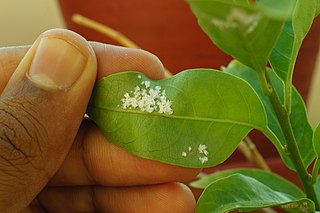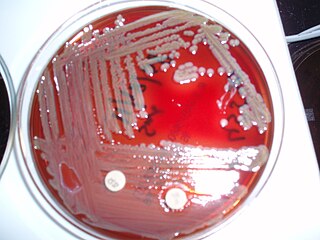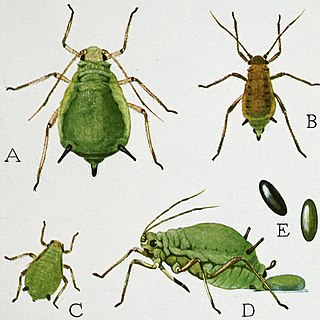
Woolly aphids are sucking insects that live on plant sap and produce a filamentous waxy white covering which resembles cotton or wool. The adults are winged and move to new locations where they lay egg masses. The nymphs often form large cottony masses on twigs, for protection from predators.

The family Flavobacteriaceae is composed of environmental bacteria. Most species are aerobic, while some are microaerobic to anaerobic; for example Ornithobacterium, Capnocytophaga, and Coenonia.
The family Sphingobacteriaceae is composed of three genera of environmental bacteria.

Watermelon mosaic virus (WMV) also known as Marrow mosaic virus, Melon mosaic virus, and until recently Watermelon mosaic virus type 2 (WMV-2), is a plant pathogenic virus that causes viral infection in many different plants. First described on squash in Florida, WMV arose from a unique recombination of genetic material contributed by Soybean mosaic virus (SMV) and Bean common mosaic virus (BCMV) along with Peanut Stripe virus (PSV).

Phylloxeridae is a small family of plant-parasitic hemipterans closely related to aphids with only 75 described species. This group comprises two subfamilies and 11 genera with one that is fossil. The genus type is Phylloxera. The Phylloxeridae species are usually called Phylloxerans or Phylloxerids.

Chaetosiphon fragaefolii, the strawberry aphid, is a bug species in the genus Chaetosiphon found in the United States (Arizona), Argentina and Chile.
The rusty plum aphid is an aphid in the superfamily Aphidoidea in the order Hemiptera. It is a true bug and sucks sap from plants.

The Ornate Aphid, or Violet aphid,, is an aphid in the superfamily Aphidoidea in the order Hemiptera. It is a true bug and sucks sap from plants. It is an invasive species.

Pentalonia nigronervosa is an aphid in the superfamily Aphidoidea in the order Hemiptera. It is a true bug and sucks sap mainly from Musa species.
The Sugarcane Woolly Aphid,, is an aphid in the superfamily Aphidoidea in the order Hemiptera. It is a true bug and sucks sap from plants. It is a foliage sucking aphid species.
The Bamboo Woolly Aphid,, is an aphid in the superfamily Aphidoidea in the order Hemiptera. It is a true bug and sucks sap from plants.
Kaltenbachiella japonica, is an aphid in the superfamily Aphidoidea in the order Hemiptera. It is a true bug and sucks sap from plants.
The Rice Root Aphid,, also known as Tetraneura (Tetraneurella) nigriabdominalis, is an aphid in the superfamily Aphidoidea in the order Hemiptera. It is a true bug and sucks sap from plants.
Catenovulum is a bacteria genus from the family of Alteromonadaceae.
Catenovulum maritimum is a Gram-negative, heterotrophic and facultatively anaerobic bacterium from the genus of Catenovulum which has been isolated from surface of the alga Porphyra yezoensis from Weihai in China.

Tetraneura ulmi, the elm sack gall aphid, is a species of aphid in the family Aphididae.

Tetraneura is a genus of woolly and gall-making aphids in the family Aphididae. There are at least 30 described species in Tetraneura.
Tenacibaculum agarivorans is a Gram-negative, aerobic, rod-shaped agar-digesting bacterium from the genus of Tenacibaculum which has been isolated from the alga from the coast of Weihai in China.







